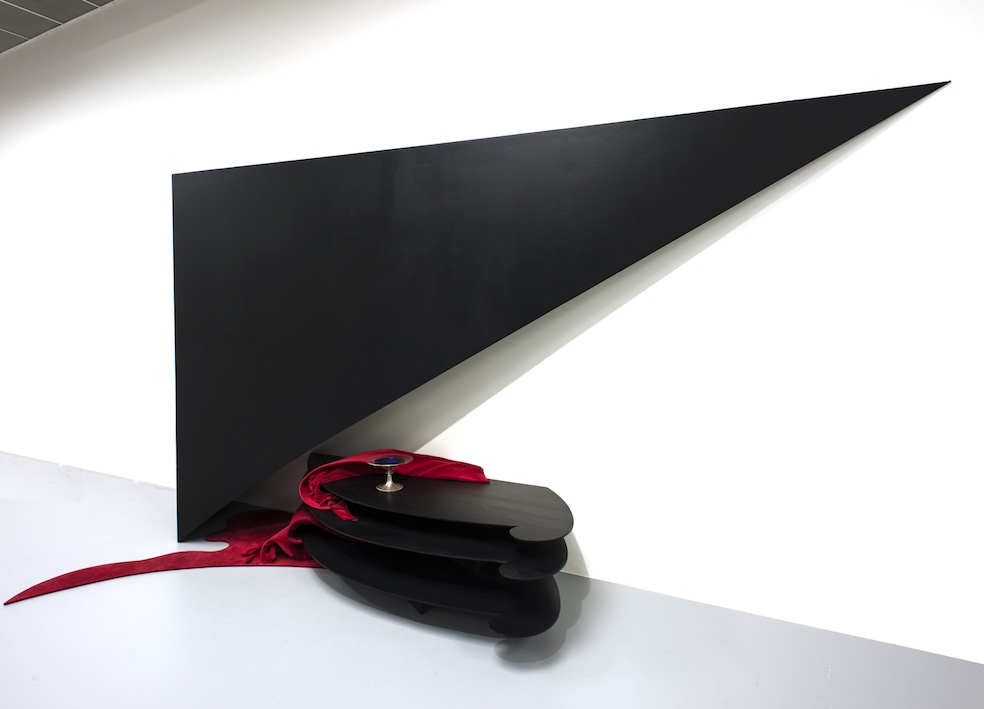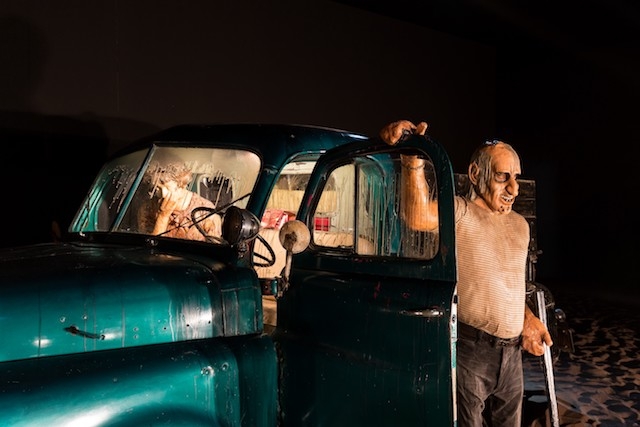Artist-curated shows are the flies in the ointment of curating. Playful and open-ended, artists don’t have to worry about their careers as curators, since that’s not their day-job. Painter Luc Tuymans’s surprising and eclectic Sanguine, is no exception. Nominally part of the bigger ‘Antwerp Baroque. Rubens Inspires’ festival cooked up by the city as part of a campaign to promote Flanders’s Baroque-era cultural riches to tourists, Sanguine puts contemporary art into often startling conversation with some Old Master paintings of the Netherlands’s Baroque heyday.
It’s not every day you see a Caravaggio and a Zurbarán two steps from a Pierre Huyghe video or an On Kawara drawing. So what’s going on here? Tuymans wants us to consider the Baroque – the grand style of art that emerged in Europe during the sixteenth century in the wake of the Catholic counter-reformation – as an idea about the affective nature of art, its ability to move and overwhelm. It’s not just a historical style, full of swooning women and suffering saints, then.

Human suffering, though, is a key theme of Sanguine, strung together between two epic works. Edward Kienholz’s installation Five Car Stud (1969-72), and Caravaggio’s The Flagellation of Christ (1571-1610). Housed in a black inflatable dome outside M KHA, the Kienholz’s Five Car Stud still shocks and revolts. Inside, the headlights of a circle of 60s American cars illuminate a violent scene in a dusty clearing. Mannequins stage a gang of masked white men, who have tied up a black man. His face caught in the agony of a scream, as another masked man takes a knife to his genitals to castrate him, as punishment for engaging in a relationship with a white woman. She looks on in tears, from the cab of a pickup truck.
It’s a hideous scene, and though fictional, it’s a distillation of the racist violence that marked civil-rights era America. In the current tensions around the politics of racism it still resonates, though whether today Five Car Stud will be vilified as another instance of ‘black death spectacle’ remains to be seen. But the question of spectacle and suffering isn’t trivial to the show’s provocation; the sight of human suffering, offered in an image, is caught in the difference between ethics and aesthetics, and how the old-fashioned notion of emotional empathy operates between them. At the far end of M KHA’s galleries is another circular, dark space, where Caravaggio’s Flagellation of Christ hangs. Here, the suffering is about to come, beyond the moment depicted, as the figure of Jesus, standing, succumbs to being bound by his captors, who are readying bundles of branches to whip him.
the sight of human suffering, offered in an image, is caught in the difference between ethics and aesthetics, and how the old-fashioned notion of emotional empathy operates between them
Tension and action oppose subordination and resignation here. It’s not as if Jesus’s body is painted without a sense of voyeuristic, erotic pleasure. It’s the same with Zurbarán’s The Martyrdom of Saint Sebastian (c.1650), tied to a tree, his naked body pierced by arrows. Let’s face it, catholic baroque certainly ‘had issues’ with the confusion of pleasure and pain, of earthly suffering as a passport to heavenly salvation (its most swooning example being perhaps Bernini’s overthetop sculpture Ecstasy of Saint Teresa, 1647–52). But Tuymans’s more secular vision extracts from this the persistent question of how art affects the senses; how, in the painter’s worlds, artworks still have the capacity to ‘overwhelm’.

In the twentieth and twenty-first centuries, the nature of the ‘overwhelming’ is a suspect presence in art, and many works here toy with that suspicion. Lili Dujourie’s 1986 sculpture The Kiss presents a tiered black podium on which stands a silver chalice, surrounded by a tumbling train of scarlet cloth. This is shadowed by a looming black wedge. Sumptuousness is here challenged by a more modernist austerity. Close by is Cornelis De Vos’s seventeenth-century Portrait of Abraham Grapheus (1620), a grumpy-looking man in a fancy ruff, his breast ridiculously adorned with large medals, looking up from his collection of jewelled, golden vessels.
Art gets bad press for being a worldly pleasure, after all. But if the darker side of things can’t be let in, what is there left? Rather than ship in the massive, mirror-gold bling totem of Takashi Murukami’s delirious The cry of the birth of a universe (2014) Tuymans has instead borrowed a vitrine full of small maquettes of elements of this crazy art-boom bauble, a large photograph of which hangs nearby. On the other side of the gallery are three book shelving-like Library sculptures by Tobias Rehberger, whose central oval sections conceal arrays of TV monitors, facing the wall, their flickering presence signalled by the light playing around the edges, and of course the noise of the film clips being played, which we cannot see. One is Monster Triumphing Library, where we hear the screams of horror-film victims as said monsters triumph. Joan Crawford Slapping Library (both 2000) is the more tempered sound of, well, Joan Crawford slapping some overstepping male charmer in the face. There’s a suggestion here of raw life being anaesthetised by art, hidden behind the toylike facade of IKEA-fied interior design banality.
‘Sanguine’ seems to want to remind us of the unstable intensities that make up a sense of human life in the raw

Sanguine, then seems to want to remind us of the unstable intensities that make up a sense of human life in the raw. There’s an apocalyptic tone though, from the Kienholz piece, to the unnerving Thanatophanies drawings by On Karawara (an early work of the 1950s, monochrome images alternating between cheerful smiling faces of everyday Japanese people and the burnt, scarred and disfigured faces of what might be the survivors of the atomic bombs). Before them, Berlinde de Bruyckere’s three life-size stuffed horses lie mangled and stricken, the title In Flanders Fields (2000) recalling the jingoistic First World War poem by John McCrae, in which the dead call on the living to carry on the fight as they lie buried.

This bleak sense of a frail humanity ends up in another Japanese-sited work, Huyghes’s deeply unsettling video Human Mask (2014). Following the calamitous 2011 earthquake and tsunami, Huyghe filmed in the evacuated urban environs of the Fukushima nuclear power plant. Based on the real story of a monkey, once trained to fetch and carry water and condiments in a restaurant, here the same monkey wanders about an abandoned eatery, wearing a dress (similar to the costume its humans would dress her in) and a Noh-style mask of a young Japanese girl, with long human hair. It runs about, sits bored and dejected, breathes anxiously, toys with its hair. The effect undermines our sense of what constitutes human presence, forcing us to concede that in Huyghe’s ‘uncanny valley’ of externalised bodily gestures, nothing much separates us from animals. It’s a manipulative, vaguely exploitative work, but then, being manipulated by one’s emotions is what Tuymans’s show invokes as the ambiguous power of art.
That art is ethically dubious, tangled up with the politics of cultural and social power, is of course what sparked the Baroque, as the catholic church went on the offensive against the iconoclastic, anti-sensual prohibitions of the protestant reformation. It’s ancient history, in a sense. But in a weird way, Tuymans’s show suggests that this foundational split in European culture – between the visual and the verbal (the puritan protestants were all about the word of the bible, after all, not the worldly incense and gold of the decadent papists) – still lingers in contemporary art’s internal battles between the verbal and ‘conceptual’ on one side, and the sensuality of the commodified art object on the other. The publicity for ‘Antwerp Baroque’ enthuses about the ‘bon vivant’, sensual aspect of baroque art. If Rubens’s art of pleasure-loving fleshiness has the virtue of celebrating human life over death, Tuymans seems to want to paint a bigger picture of the affective power of art, of pleasure and delight, but also of violence and suffering, empathy and horror. These, Sanguine suggests, still need to take their place in contemporary art, since aesthetic power is always, in the end, political.
Sanguine / Bloedrood is on show at M HKA, Antwerp, through 16 September

